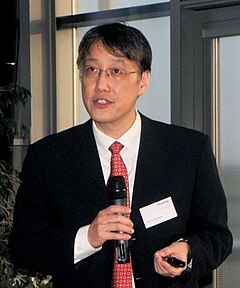Philip Kim
| Philip Kim | |
|---|---|
 |
|
| Residence | United States |
| Nationality | South Korea |
| Fields |
condensed matter physics carbon nanotubes graphene |
| Institutions |
University of California, Berkeley Columbia University Harvard University |
| Alma mater |
Seoul National University Harvard University |
| Thesis | Fundamental properties and applications of low-dimensional materials (1999) |
| Doctoral advisor | Charles Lieber |
| Known for | quantum transport in carbon nanotubes and graphene |
| Notable awards |
Ho-Am Prize in Science (2008) Oliver E. Buckley Condensed Matter Prize (2014) |
|
Website kim |
|
Philip Kim is a condensed matter physicist known for study of quantum transport in carbon nanotubes and graphene, including observations of quantum Hall effects in graphene.
Kim studied physics at Seoul National University and earned his bachelor's degree in 1990 and a master's degree in 1992, and a doctorate in applied physics at Harvard University in 1999 under the supervision of Charles Lieber. He worked at the University of California, Berkeley as a Miller Research Fellow until 2001, when he joined the faculty at Columbia University. He joined the faculty at Harvard University in 2014.
Kim and coworkers have made important contributions in the field of nanoscale low-dimensional materials. In 1999, he and Lieber published a highly cited paper on electrostatically controlled carbon nanotube NEMS devices. In Feb. 2005, his group at Columbia reported electrical measurements of thin graphite films produced by an atomic force microscope technique. In Sept. 2005, they reported observation of the quantum Hall effect in single graphene layers simultaneously with the group of Andre Geim, and in 2007, the two groups jointly published observations of the quantum Hall effect in graphene at room temperature. Kim's group authored an influential paper in 2007 describing a transport gap introduced by lithographic patterning of graphene to form nanoribbons. This was an important proof of principle in the development of graphene electronics as it allowed on-off switching of the graphene devices by a factor of 1000 at low temperature. In Feb. 2009, his group and coworkers have synthesized the large-scale graphene films by CVD method. He indicated that the quality of CVD-grown graphene is comparable to that of mechanically cleaved graphene, as observation of the half-integer quantum Hall effect in CVD-grown graphene. The group reported observation of the fractional quantum Hall effect in suspended graphene in Nov. 2009.
...
Wikipedia
